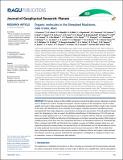Organic molecules in the Sheepbed Mudstone, Gale Crater, Mars
Author(s)
Freissinet, C.; Glavin, D. P.; Mahaffy, P. R.; Eigenbrode, J. L.; Brunner, A. E.; Buch, A.; Szopa, C.; Archer, P. D.; Franz, H. B.; Atreya, S. K.; Brinckerhoff, W. B.; Cabane, M.; Coll, P.; Conrad, P. G.; Des Marais, D. J.; Dworkin, J. P.; Fairén, A. G.; François, P.; Grotzinger, J. P.; Kashyap, S.; ten Kate, I. L.; Leshin, L. A.; Malespin, C. A.; Martin, M. G.; Martin-Torres, F. J.; McAdam, A. C.; Ming, D. W.; Navarro-González, R.; Pavlov, A. A.; Prats, B. D.; Squyres, S. W.; Steele, A.; Stern, J. C.; Sumner, D. Y.; Sutter, B.; Zorzano, M.-P.; Miller, Kristen; Summons, Roger E; ... Show more Show less
DownloadSummons_Organic molecules.pdf (4.273Mb)
PUBLISHER_CC
Publisher with Creative Commons License
Creative Commons Attribution
Terms of use
Metadata
Show full item recordAbstract
The Sample Analysis at Mars (SAM) instrument on board the Mars Science Laboratory Curiosity rover is designed to conduct inorganic and organic chemical analyses of the atmosphere and the surface regolith and rocks to help evaluate the past and present habitability potential of Mars at Gale Crater. Central to this task is the development of an inventory of any organic molecules present to elucidate processes associated with their origin, diagenesis, concentration, and long-term preservation. This will guide the future search for biosignatures. Here we report the definitive identification of chlorobenzene (150–300 parts per billion by weight (ppbw)) and C2 to C4 dichloroalkanes (up to 70 ppbw) with the SAM gas chromatograph mass spectrometer (GCMS) and detection of chlorobenzene in the direct evolved gas analysis (EGA) mode, in multiple portions of the fines from the Cumberland drill hole in the Sheepbed mudstone at Yellowknife Bay. When combined with GCMS and EGA data from multiple scooped and drilled samples, blank runs, and supporting laboratory analog studies, the elevated levels of chlorobenzene and the dichloroalkanes cannot be solely explained by instrument background sources known to be present in SAM. We conclude that these chlorinated hydrocarbons are the reaction products of Martian chlorine and organic carbon derived from Martian sources (e.g., igneous, hydrothermal, atmospheric, or biological) or exogenous sources such as meteorites, comets, or interplanetary dust particles.
Date issued
2015-03Department
Massachusetts Institute of Technology. Department of Earth, Atmospheric, and Planetary SciencesJournal
Journal of Geophysical Research Planets
Publisher
American Geophysical Union (AGU)
Citation
Freissinet, C.; Glavin, D. P.; Mahaffy, P. R.; Miller, K. E.; Eigenbrode, J. L.; Summons, R. E.; Brunner, A. E. et al. “Organic Molecules in the Sheepbed Mudstone, Gale Crater, Mars.” Journal of Geophysical Research: Planets 120, no. 3 (March 2015): 495–514 ©2015 The Authors
Version: Final published version
ISSN
2169-9100